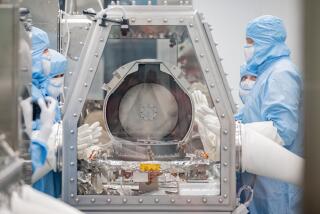NASA tests nonstick aircraft wing coatings that let bug juice slide
Who knew that keeping bug guts off airplanes could be a mission for NASA?
It turns out that insect “residue” splattering on the wings of big aircraft as they take off is a real problem looking for a serious solution.
“They are really small,” conceded Christopher Wohl, senior research materials engineer at NASA Langley Research Center in Hampton. “But the problem is that, as these residues accumulate on the wing, they can impact the airflow.”
And anything that affects airflow adds to a plane’s drag, decreasing efficiency and increasing fuel use and costs.
So about five years ago, Wohl and his team began to look into literally hundreds of nonstick coatings for airplane wings that could best slough off bug guts. They narrowed it down to the top five potentials and put them through a series of flights on Boeing’s ecoDemonstrator 757 test airplane.
Preliminary results indicate the coatings can do the job just fine, potentially saving the airline industry a bundle in cumulative fuel costs.
“Savings can be relatively small when you talk about fuel savings as far as percentage-wise — like half a percent,” Wohl said. “But the impact of that across the entire aviation industry can be really enormous.”
In fact, he said, the most promising coating managed to reduce bug residue by 40% compared with control surfaces. He estimated the potential annual savings to airlines at millions of dollars, particularly on long-distance flights for which fuel is at a premium.
The ecoDemonstrator tested out the bug-sloughing technology in Shreveport, La., which Newman called the bug capital of the country.
To come up with the right coating, Wohl said his team considered the shape of its surface on a microscopic level and its chemical composition.
Their inspiration was the lotus leaf.
The lotus leaf needs optimum sun exposure for photosynthesis, he said, and so is adept at repelling water and dirt. But the surface of the lotus leaf isn’t slick — it’s rough.
The nonstick coatings that worked best to slough off bug guts are similarly rough, like fine-grade sandpaper, and use surface tension to help roll off insect remains.
“The residue is going to come and hit, and it’s going to trap air underneath it,” Wohl explained. “And that air’s going to compress. At some point, that air isn’t going to compress anymore, and it’s going to reverse and start to come back out. As it comes back out, this expanding region of the insect guts is trying to expand. … It destabilizes that and kicks it off the surface.”
The technology could also have applications beyond aviation, he said, for things like ship hulls, automobiles and spacecraft.
“One of the things I researched when I first came here were surfaces that lunar dust wouldn’t stick to,” Wohl said. “There’s some carry-over between these technologies that we’re developing here where they could be applicable to, say, an extraterrestrial, long-duration mission on the Martian surface.”
The coatings are ready now for larger-scale investigations into durability and environmental impact, he said. NASA is reaching out to companies to gauge their interest in further tests of the materials.
More to Read
Start your day right
Sign up for Essential California for news, features and recommendations from the L.A. Times and beyond in your inbox six days a week.
You may occasionally receive promotional content from the Los Angeles Times.







